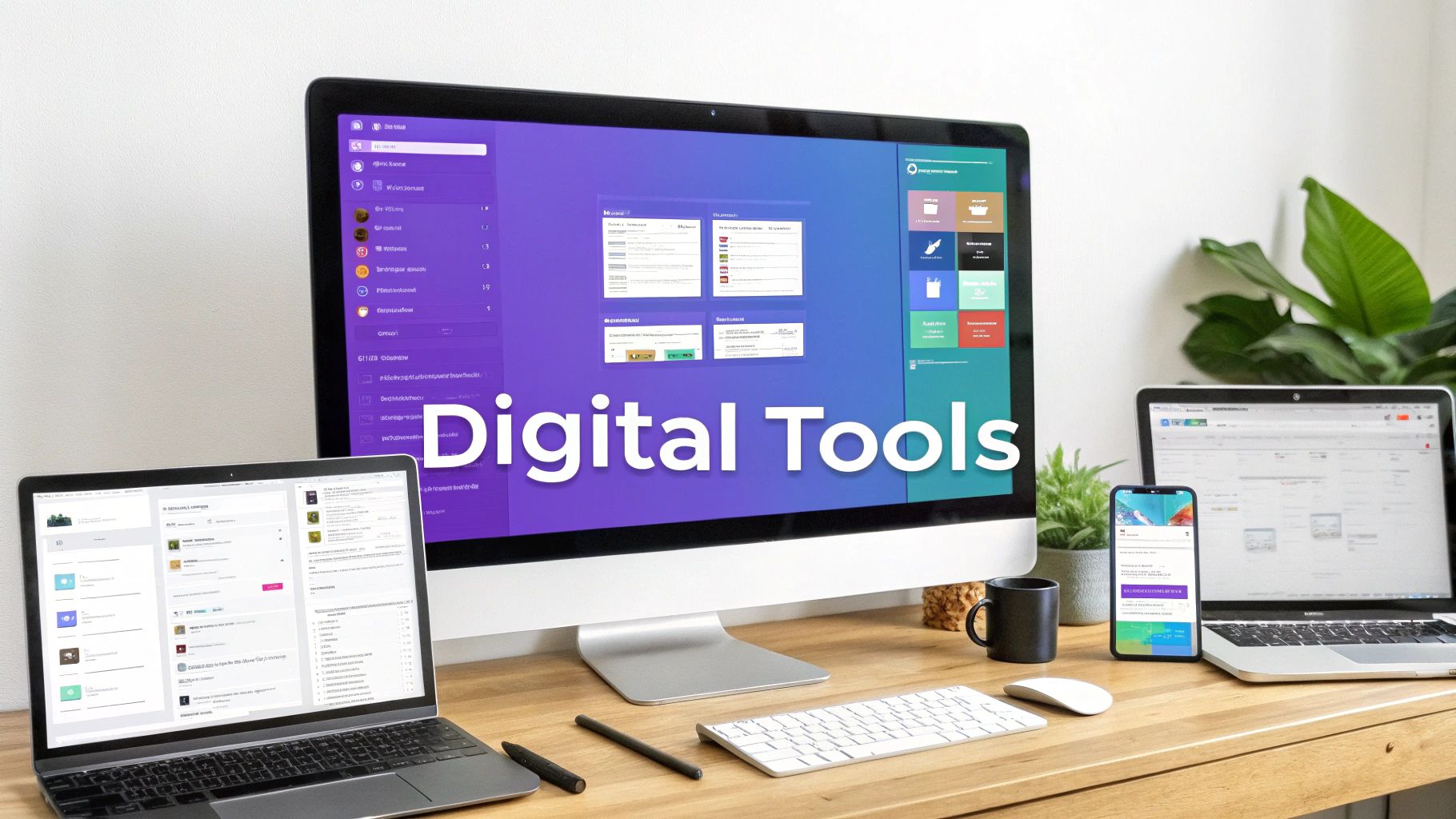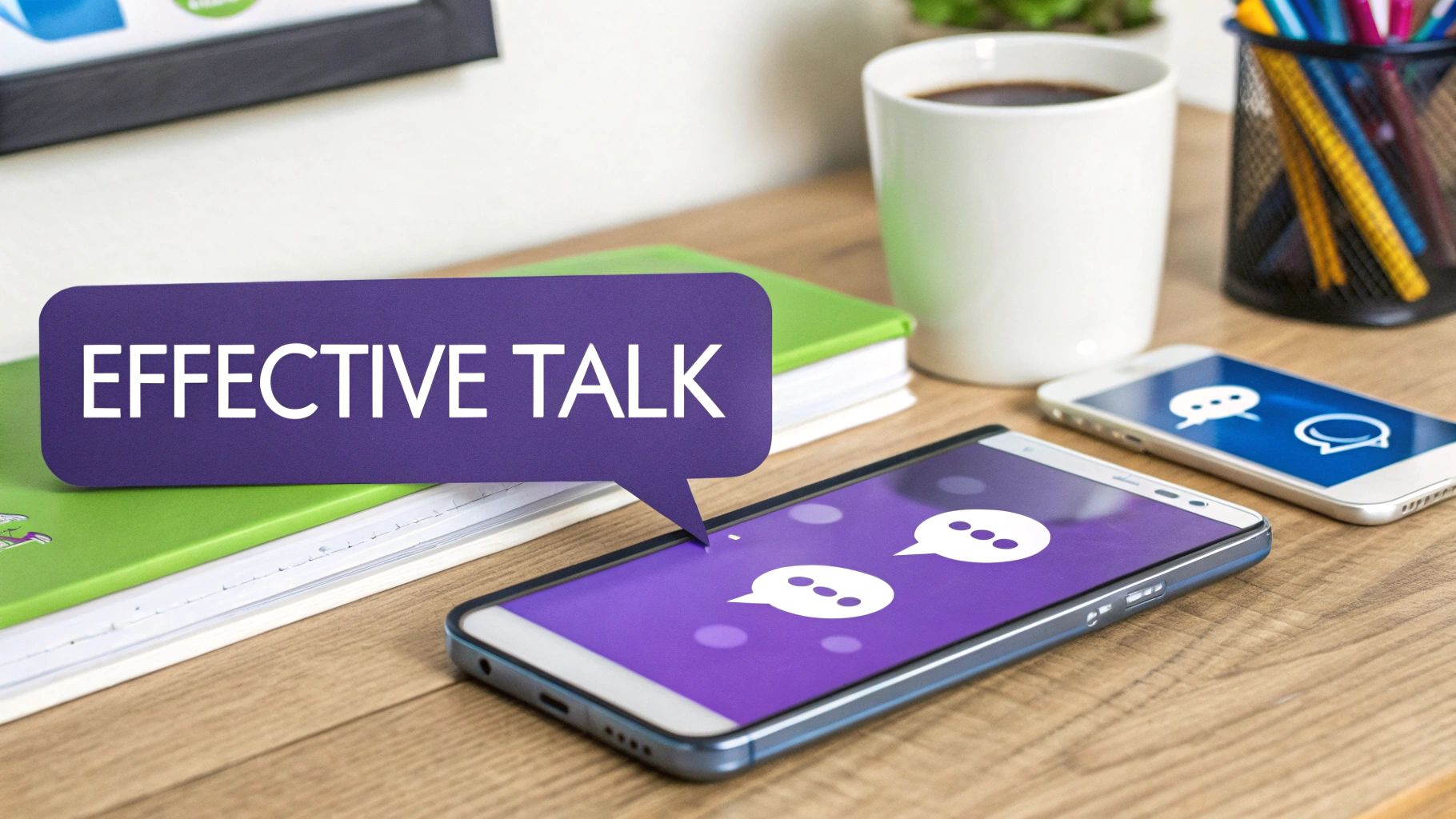Decoding the Asynchronous Work Environment

An asynchronous work environment is a different approach compared to the traditional 9-to-5 office. It’s based on the idea that work doesn’t have to happen simultaneously for all team members. Instead, individuals have the flexibility to complete their tasks and contribute to projects on their own schedules. This means meetings, real-time collaboration, and instant replies aren't the standard operating procedure.
Understanding the Core Principles of Asynchronous Work
This flexibility lets people work when they're most productive. This could be early morning, late at night, or in focused bursts throughout the day. For example, a software developer might prefer coding in the afternoon, while a marketing manager might be most creative in the morning. Asynchronous work allows them to structure their days accordingly.
Asynchronous environments also rely on clear communication and thorough documentation. This ensures everyone can access the information they need, when they need it.
This change in work style has become increasingly popular, especially since the start of the COVID-19 pandemic. By 2023, 58% of employees were working remotely at least some of the time, according to McKinsey. This highlights the growing importance of asynchronous environments, allowing employees to work at different times and maximize individual productivity. This flexibility can improve work-life balance and boost productivity by minimizing interruptions and promoting focused work. Find more detailed statistics here.
How Asynchronous Work Differs From Traditional Models
The traditional, synchronous model, with its emphasis on real-time presence and immediate responses, can create constant interruptions. Asynchronous work, however, reduces distractions and encourages deep, focused work. This is because people can dedicate blocks of uninterrupted time to complex tasks without the pressure of instant replies or back-to-back meetings.
Asynchronous work also supports distributed teams. Because collaboration doesn't require everyone to be online at the same time, teams can work across multiple time zones and locations. This allows companies to access a wider talent pool and build more diverse teams. It also creates a more inclusive environment for team members with different schedules or personal commitments.
The Hidden Advantages of Asynchronous Work

While flexibility is a clear benefit, asynchronous work environments offer much more. These often overlooked advantages can significantly impact productivity, mental health, and overall work quality. Let's explore how this model fosters deep work by minimizing interruptions and excessive meetings.
Deep Work and Productivity Gains
The constant barrage of messages and meetings can seriously disrupt focus and hinder deep work. Asynchronous work minimizes these distractions. It allows individuals to dedicate uninterrupted time to complex tasks.
This creates an environment where deep thinking and focused problem-solving thrive. This dedicated focus often leads to increased productivity and higher quality output. For example, remote workers often save 2-3.5 hours per day due to reduced commuting and fewer meetings.
The asynchronous model is particularly beneficial for global teams. It allows companies to tap into talent across different time zones without geographical limitations. Learn more about the benefits of asynchronous work at DropDesk.
Mental Health and Well-being
Asynchronous work empowers individuals to work when they're most alert and focused. This flexibility contributes to a better work-life balance and reduced stress.
Having control over one's schedule can positively impact mental health. It fosters a sense of autonomy and ownership over work. Learn more about mastering asynchronous remote work at RemoteSparks.
Documentation as a Competitive Advantage
Thoughtful documentation becomes crucial in an asynchronous work environment. This goes beyond meeting minutes. It involves creating a comprehensive knowledge base accessible to everyone, regardless of location or time zone.
This shared understanding fosters transparency and streamlines communication. It also empowers team members to work independently. This readily available information becomes a competitive advantage, ensuring consistency and enabling quick decision-making.
Accessibility and Diversity
Asynchronous work creates opportunities for individuals who thrive outside traditional office hours. This includes parents, caregivers, people with disabilities, and those in different time zones.
By offering this flexibility, organizations can build more diverse teams. They benefit from a wider range of perspectives. This inclusive environment strengthens the team and creates a sense of belonging.
To better understand the differences between synchronous and asynchronous work, let's look at a comparison table.
Synchronous vs. Asynchronous Work Comparison
A side-by-side comparison of traditional synchronous work models against modern asynchronous approaches
| Work Aspect | Synchronous Environment | Asynchronous Environment |
|---|---|---|
| Communication | Real-time meetings, instant messaging | Email, project management tools, documentation |
| Collaboration | In-person brainstorming, joint editing | Shared documents, online workspaces |
| Scheduling | Fixed work hours, simultaneous participation | Flexible work hours, independent task completion |
| Decision-making | Immediate responses, quick resolutions | Considered input, documented decisions |
| Location | Primarily office-based | Remote work friendly |
This table highlights how asynchronous work emphasizes documentation, flexible schedules, and remote work possibilities, contrasting with the real-time, in-person nature of synchronous environments.
Measurable Business Outcomes
The benefits of asynchronous work translate into tangible results. Increased productivity, improved employee morale, and a more diverse workforce all contribute to a healthier bottom line.
This model also leads to cost savings through reduced office space and other overhead expenses. These factors combine to create a more efficient, sustainable, and profitable organization.
The Essential Tech Stack for Asynchronous Teams

The right tools are crucial for a successful asynchronous work environment. This section explores the technology that empowers effective distributed teams. Instead of just listing software, we'll examine how successful remote-first companies use their tech stack for maximum impact.
Key Tool Categories for Asynchronous Collaboration
Asynchronous teams depend on several key tool categories to stay connected and productive. These tools facilitate communication, project management, and knowledge sharing – all essential for effective asynchronous work. Choosing the right tools within these categories is critical.
Let's explore these categories in more detail with a helpful table:
To understand the essential tools for asynchronous teams, take a look at the table below. It provides an overview of key tool categories, their features, popular examples, and ideal use cases.
| Tool Category | Key Features | Popular Examples | Best For |
|---|---|---|---|
| Project Management Platforms | Task assignment, Kanban boards, progress visualization, deadline tracking | Asana, Trello, Monday.com | Managing tasks, projects, and deadlines; visualizing progress |
| Document Collaboration Systems | Simultaneous editing, version control, commenting features, real-time collaboration | Google Workspace, Microsoft 365, Dropbox | Co-authoring documents, sharing files, providing feedback |
| Knowledge Management Solutions | Centralized knowledge base, searchable database, version history, access control | Notion, Confluence, Slab | Storing and retrieving information, documenting processes, sharing updates |
This table offers a starting point for building your asynchronous tech stack. Remember to consider your team's specific needs and workflows when making your final decisions. You might also be interested in this article: How to master asynchronous collaboration with the right tools.
Features That Matter
When choosing tools, focus on features that genuinely support asynchronous work. This means looking beyond the basics. Here are a few crucial features to consider:
-
Detailed Task Descriptions: Clear, comprehensive descriptions are vital, eliminating ambiguity and ensuring everyone understands their responsibilities.
-
Version History and Commenting: Tracking changes and giving feedback within documents promotes transparency and reduces misunderstandings. Robust version history also safeguards against lost work.
-
Searchable Knowledge Base: A searchable knowledge base is crucial for efficient information retrieval, empowering team members to find answers independently.
-
Integration Capabilities: Tools that integrate with each other create a more efficient workflow. Seamless data flow between platforms avoids redundant work and maintains data consistency.
Implementation Strategies for Success
Successfully implementing these tools requires thoughtful planning. Simply adopting software isn't enough; it's about integrating it into your team's daily workflow.
-
Establish Clear Communication Protocols: Define how and when different communication channels will be used. This ensures efficient information flow and minimizes confusion.
-
Provide Comprehensive Training: Make sure all team members know how to use the chosen tools effectively. This maximizes your return on investment and fosters team-wide adoption.
-
Regularly Evaluate Tool Effectiveness: Periodically review whether the chosen tools meet the team's evolving needs. This allows for adjustments and ensures your tech stack remains optimized for peak performance.
By thoughtfully selecting and implementing the right tools, teams can create a productive and fulfilling asynchronous work environment. This enhances productivity and promotes a more flexible work experience.
Communication That Works Across Time Zones

Communication breakdowns are a big challenge for teams working across different time zones. This section explores how successful distributed teams stay connected and maintain clarity, even when they aren't constantly interacting in real time. We'll cover everything from writing effective messages to establishing shared expectations.
Crafting Clear and Context-Rich Messages
When working asynchronously, your messages need to be self-sufficient. This means including all the necessary context upfront. For example, if you're emailing feedback on a design, don't just attach the file. Explain the project goals, highlight specific areas for feedback, and clearly state the deadline.
This comprehensive approach minimizes back-and-forth for clarification and keeps projects moving smoothly. Clear subject lines are also essential. "Project Update: Website Redesign Mockups" is far more helpful than "Quick Question," allowing team members to prioritize messages and easily find information later.
Team Agreements and Response Times
Setting clear expectations for communication is vital. This involves creating team agreements about response times. For instance, a team might agree to respond to non-urgent messages within one business day.
While instant replies aren't mandatory, acknowledging receipt and providing a response timeframe becomes the standard. This approach manages expectations, reduces anxiety around unanswered messages, and creates a predictable communication flow. For effective communication management, consider using Remote Team Collaboration Software.
Choosing the Right Communication Channels
Different communication channels have different purposes. Instant messaging is ideal for quick check-ins and urgent matters. Project management tools are best suited for task updates and feedback.
Email, on the other hand, is best reserved for formal communication and detailed project information. Using each channel strategically ensures that the right information reaches the right people in the most effective way. This targeted approach maximizes clarity and efficiency.
Documentation and Knowledge Sharing
Effective documentation is a game-changer. Organize information logically, use clear language, and keep it updated. A well-maintained wiki or knowledge base, for example, becomes an invaluable resource.
This empowers team members to find answers independently, reducing the need for repetitive questions and boosting overall team efficiency. It also frees up time for more strategic work.
Respecting Focus Time
It's crucial to establish communication protocols that respect focused work. Consider designating specific "focus hours" where interruptions are minimized. Encourage the use of status updates in communication tools to signal availability.
These practices create an environment conducive to deep work, reducing the pressure for immediate responses and fostering a more productive workflow.
Resolving Misunderstandings
Misunderstandings are bound to happen in any team. In asynchronous environments, these can quickly escalate if not addressed proactively. Establish clear protocols for resolving conflicts.
This might include scheduling a virtual meeting for open discussion or using a neutral third party for mediation. By prioritizing open communication and providing conflict resolution tools, teams can maintain strong relationships. This builds trust and strengthens team cohesion.
Building Authentic Culture Without Face Time
Creating a strong company culture within an asynchronous work environment comes with its own set of challenges. How can you build real connections when consistent face-to-face interaction isn't possible? This section explores how successful asynchronous teams cultivate a thriving culture across distances. We'll move beyond the standard virtual happy hour and into strategies that truly connect team members.
Meaningful Social Interaction
Developing relationships remotely requires a conscious effort. Instead of mandatory social gatherings, concentrate on creating chances for natural interaction. This might include virtual coffee breaks, online groups based on shared interests, or team-building activities centered around collaboration.
Some companies, for example, arrange virtual cooking classes, online game tournaments, or book clubs to bring employees together around common interests. These relaxed settings allow team members to connect personally, fostering camaraderie outside of work projects. This, in turn, strengthens team bonds and creates a stronger sense of community. Read also: How to master remote team building.
Effective Remote Onboarding
Onboarding new hires in an asynchronous setting needs a structured approach. Develop a detailed onboarding document that clearly outlines company values, communication guidelines, and key resources.
Consider pairing new employees with a mentor or buddy to guide them through the first few weeks. This offers individual support and helps integrate new team members into the company culture. Consistent check-ins and feedback sessions are also important to ensure a seamless transition.
Celebrations and Recognition
Recognizing accomplishments and celebrating milestones is vital for team morale. In asynchronous work, these celebrations often look different. Publicly acknowledge achievements in team communication channels like Slack or Microsoft Teams, or organize virtual award ceremonies.
Personalized messages or small gifts can also demonstrate appreciation. These gestures reinforce positive contributions and promote a sense of belonging, even when team members are geographically dispersed.
Establishing Shared Values
Clearly defined values are the bedrock of any strong culture. When working asynchronously, documenting and communicating these values is even more important. Create a central location, such as a company wiki or intranet, to outline these core principles.
Regularly reinforce these values through internal communications and leadership by example. This ensures that everyone, regardless of location or work schedule, understands and embodies the company's core beliefs. This shared understanding fosters trust and improves the overall team dynamic.
Maintaining Human Connection
While respecting individual schedules and personal boundaries is paramount in asynchronous work, maintaining human connection is equally important. Encourage regular informal communication, whether it's a quick message to check in or a virtual coffee chat.
Make time for casual conversations outside of project discussions. This helps team members stay connected, develop rapport, and foster a sense of community within the virtual workspace. This contributes to a more supportive work environment and further strengthens the bonds within the team.
Conquering the Real Challenges of Async Work
Working asynchronously offers incredible flexibility, but it also presents unique challenges. This section addresses these potential pitfalls and offers practical strategies, drawing insights from seasoned remote workers.
Combating Isolation and Maintaining Boundaries
One of the biggest hurdles with asynchronous work is the potential for isolation. Since team members aren't physically together, it's important to create opportunities for connection. This could involve scheduling regular virtual coffee breaks, setting up online social groups, or planning virtual team-building activities.
Another key aspect is maintaining healthy boundaries. When work is always accessible, it's easy to blur the lines between professional and personal life. Setting clear work hours and sticking to them is vital to prevent burnout. This might involve using "do not disturb" notifications during off-hours or implementing time management techniques.
Ensuring Equitable Treatment
In hybrid teams with both remote and in-office employees, equitable treatment can be a challenge. It’s essential that remote team members have the same opportunities for career advancement and access to information as their in-office counterparts.
This requires transparent communication and clear performance metrics that apply to all employees, regardless of location. Regular check-ins and feedback sessions can also help ensure remote employees feel valued and supported.
Visibility and Career Advancement
Demonstrating contributions and ensuring visibility for career advancement can be tricky in an asynchronous setting. Actively documenting accomplishments and sharing progress updates becomes incredibly important. This creates a clear record of achievements and keeps remote employees top-of-mind for leadership.
Effectively using project management tools like Asana or Trello and documenting progress transparently also helps ensure contributions are recognized.
Collaboration Across Time Zones
Asynchronous work allows for flexibility, but effective collaboration across time zones requires careful planning. Clear communication protocols, designated overlap hours for meetings, and detailed documentation are essential for smooth project execution.
Teams can use project management software with features like shared calendars and task assignment tools to streamline communication and keep everyone on the same page.
Maintaining Connection Without Constant Communication
While over-communication can be a problem in asynchronous work, maintaining a sense of connection without constant interaction is still crucial. This can be achieved by scheduling regular team meetings, using communication channels strategically, and fostering open dialogue. Creating opportunities for informal interaction, like virtual social events, can also help build camaraderie.
For remote teams looking to enhance their brainstorming and collaboration, Bulby offers a powerful solution. With its AI-powered guidance and structured exercises, Bulby helps teams break through creative blocks and develop innovative solutions. Learn more about how Bulby can empower your remote team.

